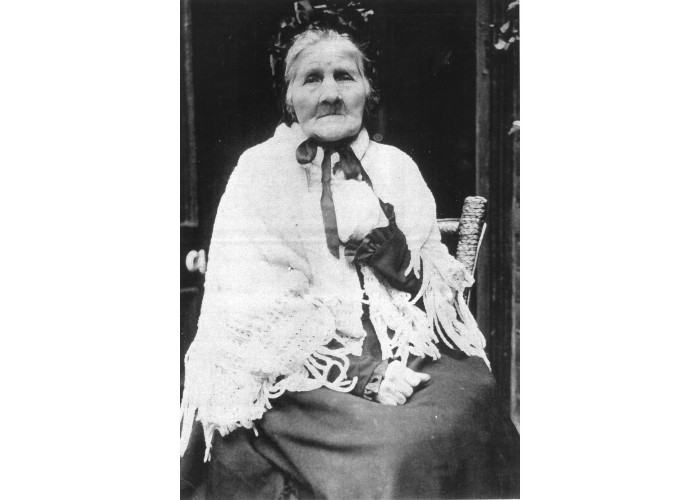Photograph of Elizabeth Watkins
This is a photograph of Elizabeth Watkins, the “last survivor” of the Battle of Waterloo, taken in 1904 – 89 years after the Battle in June 1815. Elizabeth was just 5 years old when she accompanied her mother, Mary, to help care for the British wounded in the Waterloo campaign. She was one of many women and children on the battlefield, often related or married to soldiers, who acted as unpaid nurses, cooks, and stretcher-bearers.
Elizabeth was born in Beaminster, Norwich, on 31 January 1810. Her father, Daniel Gale, joined the 95th (Rifles) Regiment shortly before the Battle of Waterloo, and Elizabeth and Mary Gale travelled with the regiment when they were sent to the Netherlands in May 1815. This was not unusual – the British Army allowed a small number of soldier’s wives to accompany the regiment on campaign.
They were unpaid, and received only half the rations of a soldier. Most earned extra money washing soldier’s clothes, and acting as hairdressers, nurses, or prostitutes. Some acted as “sutlers” – civilians who accompanied the army selling food, alcohol and other necessities – and could become quite wealthy. It was of course a hard and dangerous life, subject to military discipline (including flogging) and in danger of rape or death at the hands of the enemy.
Despite this, there was much competition to be one of the wives chosen to go campaign – just six for every hundred men in 1801. They were selected randomly on the dock when the regiment set sail from England, and there were heart-rending scenes as families were broken up – perhaps forever, as regiments might spend years on active service, or be stationed to garrison duty in distant parts of the British Empire. Mary Gale would probably have considered herself & Elizabeth lucky to follow Daniel to Waterloo in 1815.
On 18 June 1815, Elizabeth and Mary were in a women’s camp a short distance from the Battle of Waterloo. This soon turned into a makeshift hospital as thousands of wounded men limped, crawled or were carried from the battlefield. There were never enough military surgeons available, and women and children had to treat and nurse the wounded, and comfort the dying. Elizabeth remembered tearing up lint (loose fibres from cloth) to be used to stuff wounds and stop bleeding.
Elizabeth, Daniel and Mary survived the battle, and returned to England and Beaminster – the census records them living there as late as 1841. Elizabeth died in 1904, aged 95. Her tombstone describes her as “a veteran of Waterloo”.
-
Curatorial info
- Originating Museum: Private collection
- Production Date: 1904
- Technique: Photograph
-
Use this image
You can download and use the high resolution image for use in a non-profit environment such as a school or college, but please take note of the license type and rights holder information below
- Rights Holder: Private collection
- License Type:
Public domain
Private Collection
Some objects - such as this one - are owned by private collectors. Waterloo 200 cannot give information on the ownership or location of these items.






